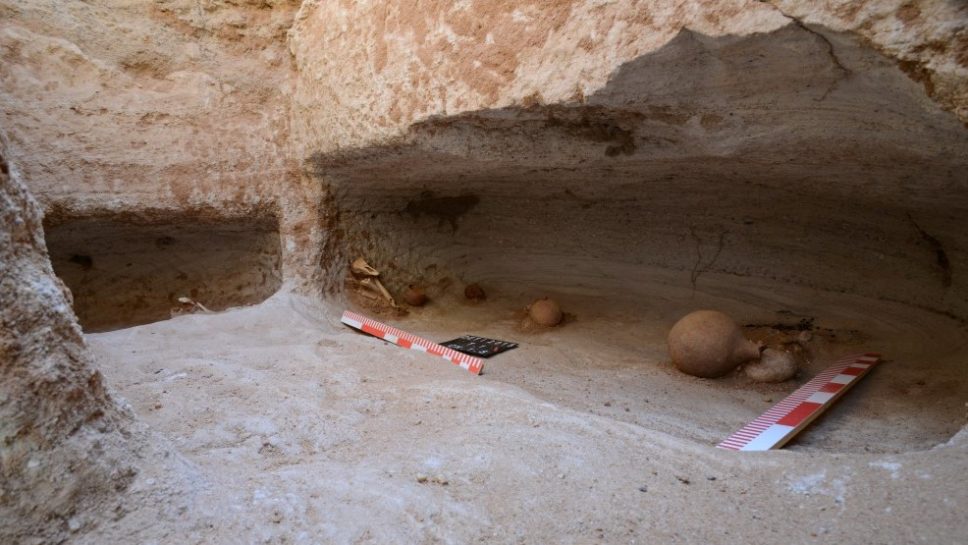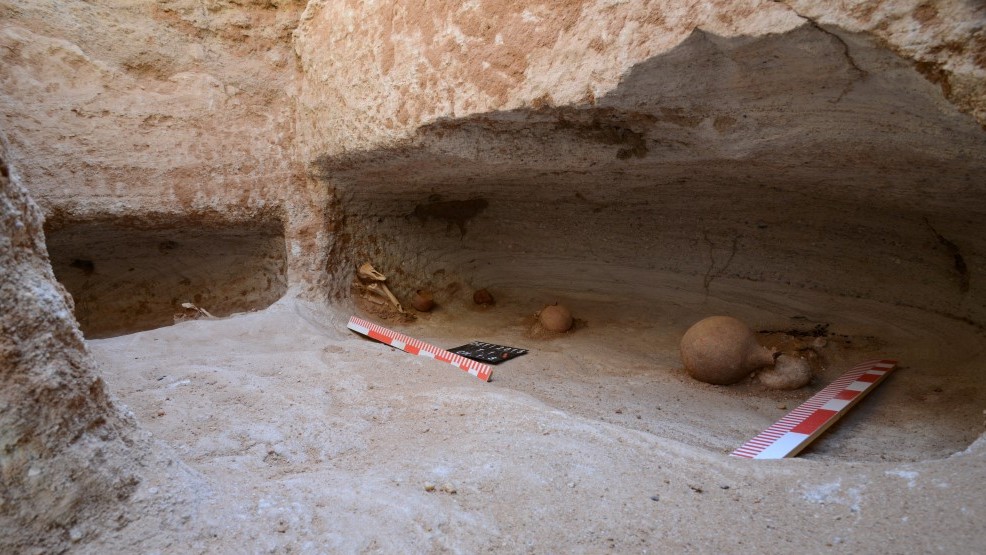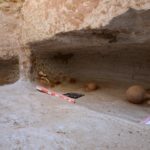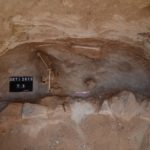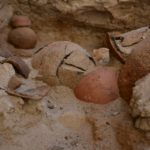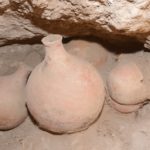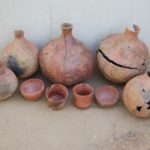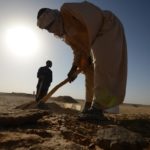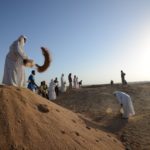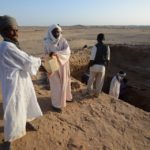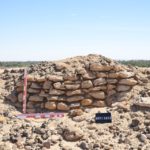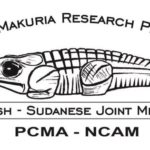El-Detti
-
Project name:
Early Makuria Research Project
M to M (Meroe to Makuria)Project logo:

-
Type of site:
Cemetery: tumuli graves
Location:
Sudan
Northern province, between the 3rd and 4th cataract, on the right bank of the Nile
Area of the ancient kingdom of MakuriaDating:
– Early Makuria period, 2nd phase (mid-4th to mid-6th century AD)
Most interesting finds:
– Sepulchral architecture: over 50 tumuli
– Pottery vessels
History of research:
Investigated by the PCMA mission in:
2014–
Type of research:
Excavations
Director:
Mahmoud El-Tayeb, Polish Centre of Mediterranean Archaeology, University of Warsaw
Co-operating institutions:
– Polish Centre of Mediterranean Archaeology, University of Warsaw
– National Corporation for Antiquities and Museums (NCAM)
Additional information:
In 2014–2015, the research was funded by the Nubian Archaeological Development Organization Qatar-Sudan Archaeological Project (QSAP). In the framework of the El-Detti project, a National Science Centre grant was realized by Urszula Iwaszczuk: “Opportunities for the El-Zuma/El-Detti and Tanqasi microregions economy research on the basis of animal bone remains from the funerary context” (2014/13/N/HS3/04620).
The mission’s work includes anthropological (Robert Mahler) and archaeozoological research (Urszula Iwaszczuk) as well as studies on pottery (Ewa Czyżewska-Zalewska), metal objects (Łukasz Zieliński) and adornments (Joanna Then-Obłuska). Every year during the excavation season, the team carries out a training program for students of archaeology from the Dongola University (Department of Archaeology in Karima), the Neelain University in Khartoum and the University in Khartoum North, as well as a training program for the NCAM staff.
Description of the site and research:
The El-Detti site apparently caught the attention of American archaeologist G.A. Reisner in 1919. He excavated a few of the tumuli and drew a plan of the cemetery. El-Detti was also visited in 1992 during a survey conducted as part of a joint project of the Sudanese National Corporation for Antiquities and Museums (NCAM) and the University of Cassino (I. Vincentelli).
Currently, research in El-Detti is carried out in the framework of the MtoM / Early Makuria Research Project, as a result of the cooperation of PCMA UW and NCAM. Surveying and documentation work on the site began in 2014; excavations were carried out only in the 2015 season.
The site is a vast cemetery from the Early Makuria period with more than 50 recorded tumuli. The majority of them have been destroyed by robbers and modern construction work (leveling of the terrain for road construction).
The mission explored seven tumuli in order to examine their construction and compare it to the sepulchral architecture from El-Zuma. Pottery finds and architecture suggest that both sites functioned at roughly the same time. The examination of the tumuli from El-Detti confirmed that they belong to types II and III distinguished earlier in El-Zuma, that is:
Type II – approximately 10 tumuli. A mound with a flat top. It is 2–3 m high and 20–30 m in diameter at the base. There is no tunnel; the main grave shaft is U-shaped and has a pier on the eastern side. The main chamber is located by the south wall and accompanied by 2–3 additional chambers. Grave chambers in tumuli of this type were originally blocked with unworked stones, mudbricks or fired bricks which presumably came from an earlier official building, dated to the Meroitic period.
Type III – the smallest structures. The mound is approximately 10–15 m in diameter at the base and no more than 0.7 m high. On the ground level, it is surrounded by a ring of stones. Tumuli of this type have a rectangular shaft aligned N-S; its dimensions are approximately 2–3 m by 1.5–2 m, and it is from 2 to 3 m deep. Sometimes there is an additional step in the corner of the shaft or a bench on its eastern side. Tumuli of type III feature only one chamber, usually, though not always, located on the western side. Two chambers have been found only in one case. The location of the chamber on the western side is a reference to the Meroitic architectural tradition.
The differences between grave types are an expression of different social statuses of the buried individuals rather than chronological indicators.
A wall or a kind of fence, which runs to the south-east of the cemetery, was presumably related to a Christian site (not yet recognized), as suggested by fragments of pottery vessels found nearby. Thus, the settlement at the El-Detti site seems to have continued in the Christian period. This is even more evident in the village of Kajabi which lies further to the south.
Results of the research:
Season by season – PCMA Newsletter
El-Tayeb, M., Czyżewska-Zalewska, E., Kowarska, Z., Lenarczyk, S., appendix: Zieliński, Ł. (2016). Early Makuria Research Project: Interim report on the excavations at El-Detti in 2014 and 2015, Appendix: Metal objects from the El-Detti cemetery. Polish Archaeology in the Mediterranean, 25, 403–430.
Iwaszczuk, U. (2016). Animals from tumuli in El-Detti, Sudan: From bone remains to studying ritual. Polish Archaeology in the Mediterranean, 25, 431–446.
Select site bibliography:
El-Tayeb, M. (2012). Funerary traditions in Nubian Early Makuria (=GAMAR Monograph Series 1). Gdańsk: Muzeum Archeologiczne w Gdańsku.
Garcea, E.A.A. and Sebastiani, R. (1998). Advantages and limitations of surveys: The case of the Napatan region. Archéologie du Nil Moyen, 8, 55–83
Gallery:
-
1. Orthophotomap of the El-Detti site / Ortofotomapa stanowiska w El-Detti (fot. A. Kamrowski, S. Lenarczyk)
-
2. Burial chambers in tumulus 1 / Komory grobowe w tumulusie nr 1 (fot. A. Kamrowski)
-
3. Interior of the burial chamber in tumulus 5. The ceiling has not been preserved, and the chamber itself was looted already in antiquity; visible are the remains of the skeleton of the deceased and fragments of pottery vessels / Wnętrze komory grobowej w tumulusie nr 5. Strop komory nie zachował się, a wnętrze zostało wyrabowane już w starożytności, na zdjęciu widoczne są pozostałości szkieletu zmarłego oraz fragmenty naczyń ceramicznych (fot. A. Kamrowski)
-
4. Fragments of pottery vessels found in the burial chamber of tumulus 3 / Fragmenty naczyń ceramicznych znalezionych w komorze grobowej tumulusa nr 3 (fot. A. Kamrowski)
-
5. Pottery vessels found in the burial chamber of tumulus 4 / Naczynia ceramiczne znalezione w komorze grobowej tumulusa nr 4 (fot. A. Kamrowski)
-
6. Excavations at the El-Detti site / Prace wykopaliskowe na stanowisku El-Detti (fot. A. Kamrowski)
-
7. Excavations at the El-Detti site, clearing the shaft of tumulus 1 / Prace wykopaliskowe na stanowisku El-Detti, odsłanianie szybu tumulusa nr 1 (fot. A. Kamrowski)
-
8. Excavations at the El-Detti site, clearing of the shaft of tumulus 1 / Prace wykopaliskowe na stanowisku El-Detti, odsłanianie szybu tumulusa nr 1 (fot. A. Kamrowski)
-
9. Workers employed by the Polish mission / Robotnicy współpracujący z polską misją (fot. A. Kamrowski)
-
10. Section of a wall running to the north-east of the site / Fragment muru biegnącego na północny-wschód od stanowiska (fot. A. Kamrowski)
-
11. Pottery vessel assemblage found in tumulus 3 / Zestaw naczyń ceramicznych odkrytych w tumulusie nr 3 (fot. A. Kamrowski)
-
12. a, b Agricultural tool (a hoe?) found during the exploration of tumulus 4 / Narzędzie rolnicze (motyka?) znalezione podczas eksploracji tumulusa nr 4 (fot. A. Kamrowski)
-
Early Makuria Research Project – Logo

